Comparing Organizational Cultures and Managerial Processes: A Report
VerifiedAdded on 2020/03/16
|20
|4585
|36
Report
AI Summary
This report analyzes cross-cultural management, focusing on organizational culture and managerial processes in Australia and France. It utilizes Hofstede's framework to compare individualism versus group orientation, communication styles, decision-making procedures, leadership approaches (autocratic vs. delegated), superior-subordinate relationships, and team management practices. The report examines how these dimensions differ between the two countries, drawing on survey data and research findings. It highlights the individualistic nature of Australian culture and contrasts it with the French context, considering factors such as communication openness, power distance, and leadership styles. The study concludes by emphasizing the importance of understanding cross-cultural differences for effective management in a globalized environment. It provides insights into how these cultural variations influence organizational dynamics and managerial effectiveness, offering practical implications for businesses operating internationally.
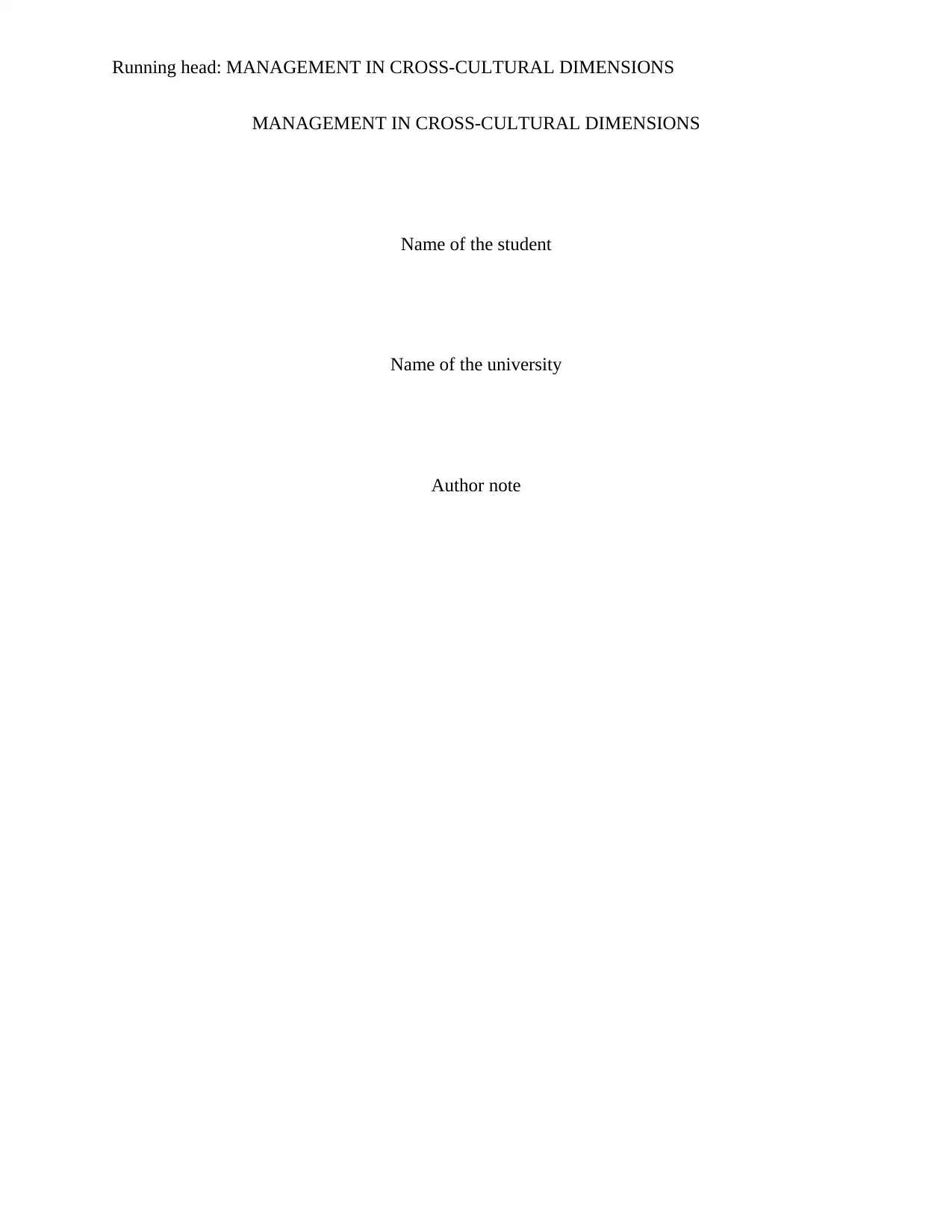
Running head: MANAGEMENT IN CROSS-CULTURAL DIMENSIONS
MANAGEMENT IN CROSS-CULTURAL DIMENSIONS
Name of the student
Name of the university
Author note
MANAGEMENT IN CROSS-CULTURAL DIMENSIONS
Name of the student
Name of the university
Author note
Paraphrase This Document
Need a fresh take? Get an instant paraphrase of this document with our AI Paraphraser
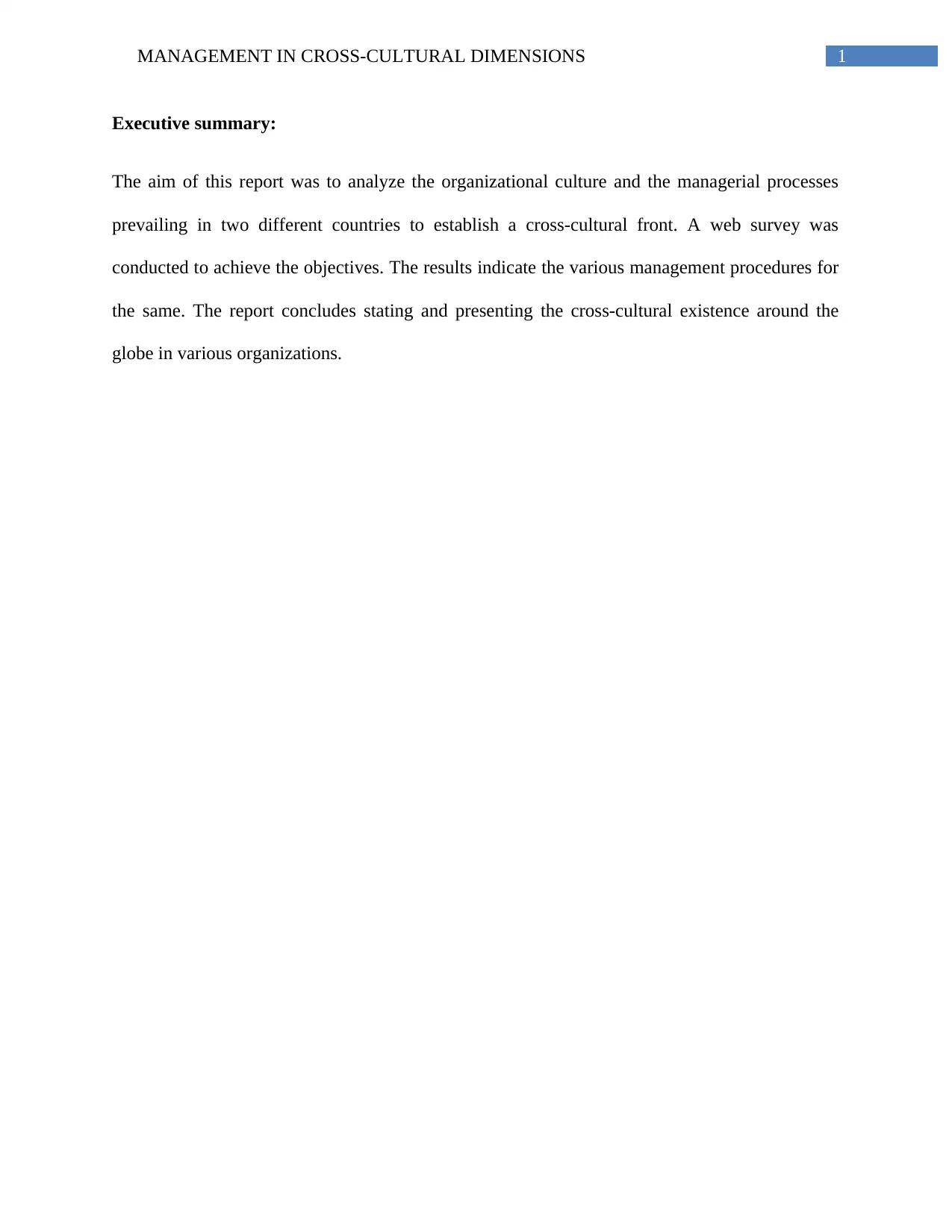
1MANAGEMENT IN CROSS-CULTURAL DIMENSIONS
Executive summary:
The aim of this report was to analyze the organizational culture and the managerial processes
prevailing in two different countries to establish a cross-cultural front. A web survey was
conducted to achieve the objectives. The results indicate the various management procedures for
the same. The report concludes stating and presenting the cross-cultural existence around the
globe in various organizations.
Executive summary:
The aim of this report was to analyze the organizational culture and the managerial processes
prevailing in two different countries to establish a cross-cultural front. A web survey was
conducted to achieve the objectives. The results indicate the various management procedures for
the same. The report concludes stating and presenting the cross-cultural existence around the
globe in various organizations.
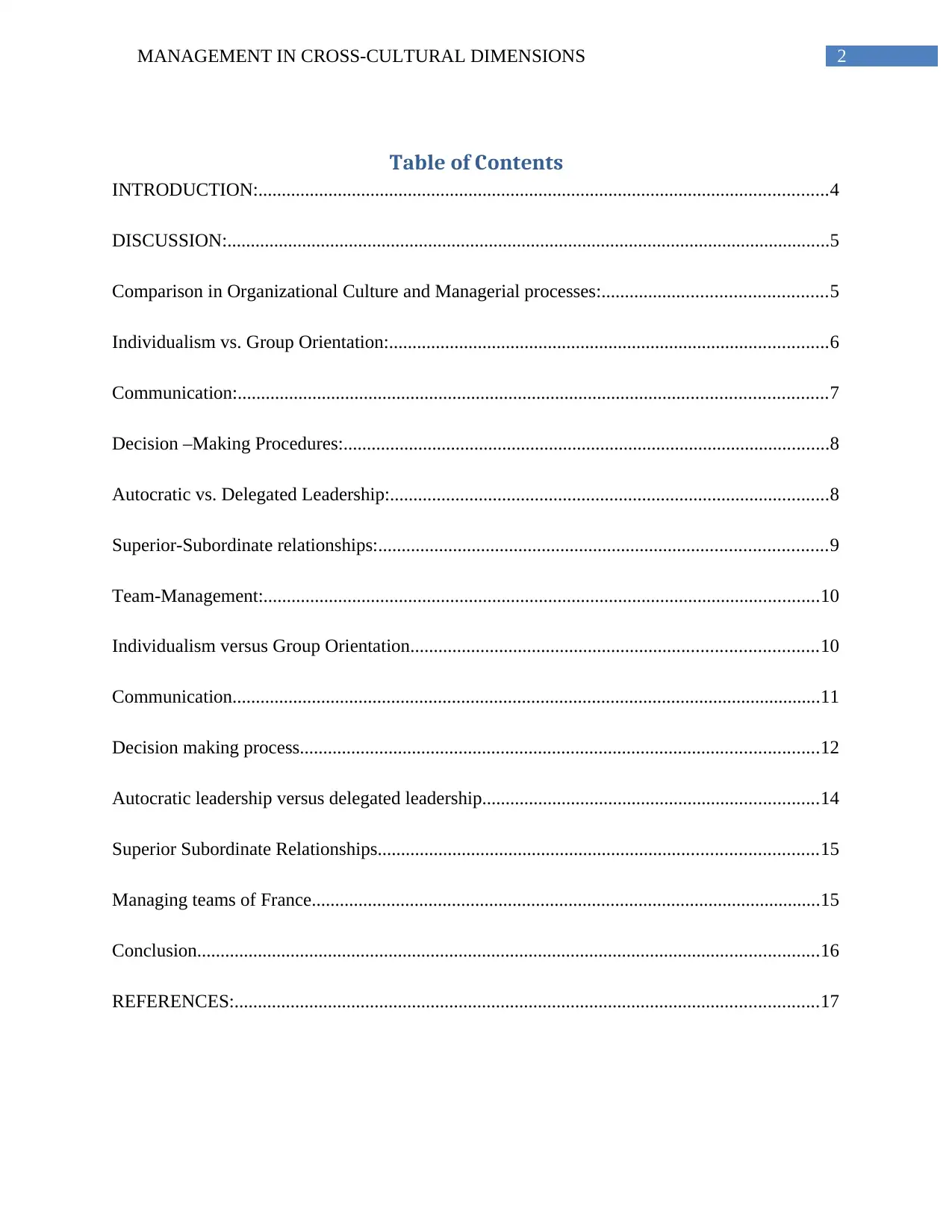
2MANAGEMENT IN CROSS-CULTURAL DIMENSIONS
Table of Contents
INTRODUCTION:..........................................................................................................................4
DISCUSSION:.................................................................................................................................5
Comparison in Organizational Culture and Managerial processes:................................................5
Individualism vs. Group Orientation:..............................................................................................6
Communication:..............................................................................................................................7
Decision –Making Procedures:........................................................................................................8
Autocratic vs. Delegated Leadership:..............................................................................................8
Superior-Subordinate relationships:................................................................................................9
Team-Management:.......................................................................................................................10
Individualism versus Group Orientation.......................................................................................10
Communication..............................................................................................................................11
Decision making process...............................................................................................................12
Autocratic leadership versus delegated leadership........................................................................14
Superior Subordinate Relationships..............................................................................................15
Managing teams of France.............................................................................................................15
Conclusion.....................................................................................................................................16
REFERENCES:.............................................................................................................................17
Table of Contents
INTRODUCTION:..........................................................................................................................4
DISCUSSION:.................................................................................................................................5
Comparison in Organizational Culture and Managerial processes:................................................5
Individualism vs. Group Orientation:..............................................................................................6
Communication:..............................................................................................................................7
Decision –Making Procedures:........................................................................................................8
Autocratic vs. Delegated Leadership:..............................................................................................8
Superior-Subordinate relationships:................................................................................................9
Team-Management:.......................................................................................................................10
Individualism versus Group Orientation.......................................................................................10
Communication..............................................................................................................................11
Decision making process...............................................................................................................12
Autocratic leadership versus delegated leadership........................................................................14
Superior Subordinate Relationships..............................................................................................15
Managing teams of France.............................................................................................................15
Conclusion.....................................................................................................................................16
REFERENCES:.............................................................................................................................17
⊘ This is a preview!⊘
Do you want full access?
Subscribe today to unlock all pages.

Trusted by 1+ million students worldwide

3MANAGEMENT IN CROSS-CULTURAL DIMENSIONS
Paraphrase This Document
Need a fresh take? Get an instant paraphrase of this document with our AI Paraphraser
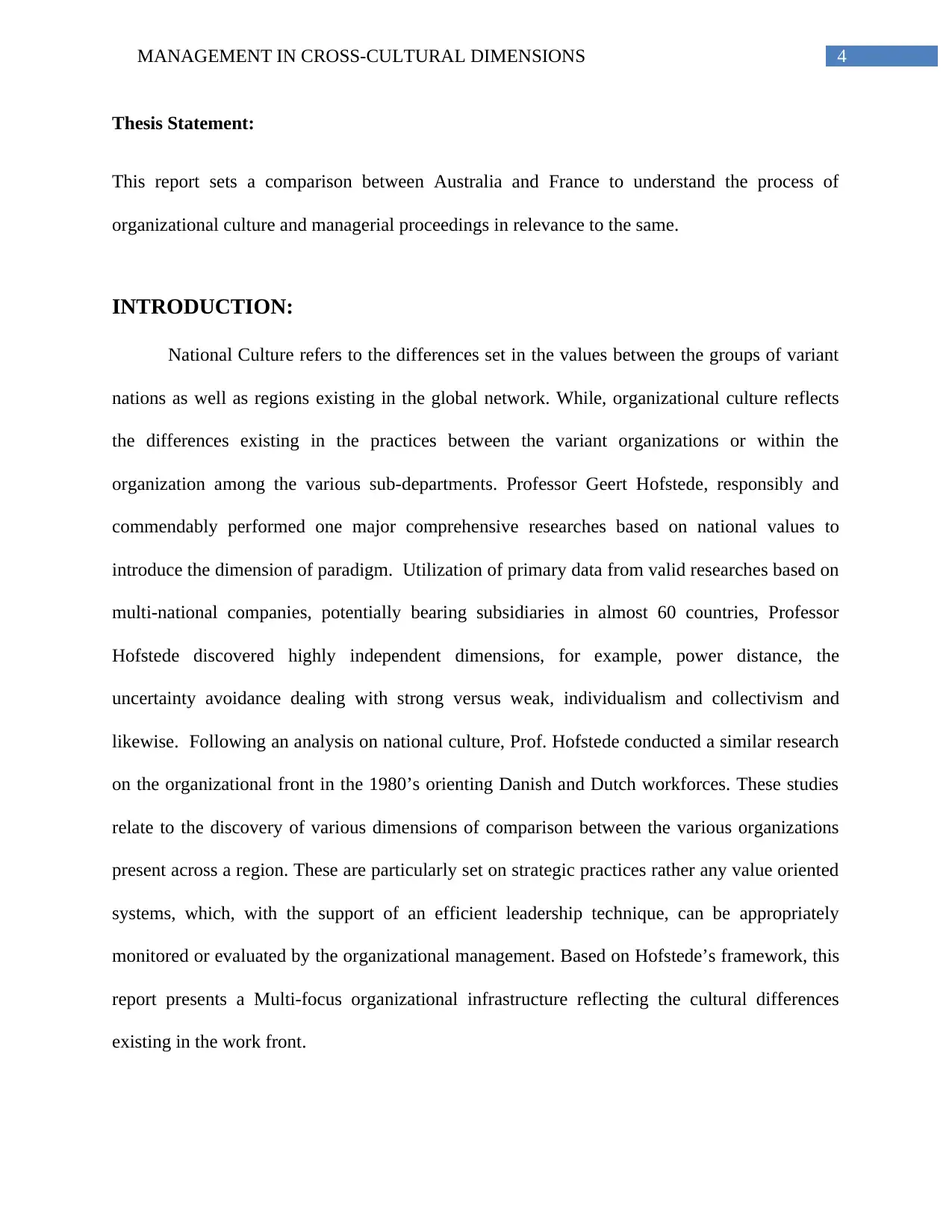
4MANAGEMENT IN CROSS-CULTURAL DIMENSIONS
Thesis Statement:
This report sets a comparison between Australia and France to understand the process of
organizational culture and managerial proceedings in relevance to the same.
INTRODUCTION:
National Culture refers to the differences set in the values between the groups of variant
nations as well as regions existing in the global network. While, organizational culture reflects
the differences existing in the practices between the variant organizations or within the
organization among the various sub-departments. Professor Geert Hofstede, responsibly and
commendably performed one major comprehensive researches based on national values to
introduce the dimension of paradigm. Utilization of primary data from valid researches based on
multi-national companies, potentially bearing subsidiaries in almost 60 countries, Professor
Hofstede discovered highly independent dimensions, for example, power distance, the
uncertainty avoidance dealing with strong versus weak, individualism and collectivism and
likewise. Following an analysis on national culture, Prof. Hofstede conducted a similar research
on the organizational front in the 1980’s orienting Danish and Dutch workforces. These studies
relate to the discovery of various dimensions of comparison between the various organizations
present across a region. These are particularly set on strategic practices rather any value oriented
systems, which, with the support of an efficient leadership technique, can be appropriately
monitored or evaluated by the organizational management. Based on Hofstede’s framework, this
report presents a Multi-focus organizational infrastructure reflecting the cultural differences
existing in the work front.
Thesis Statement:
This report sets a comparison between Australia and France to understand the process of
organizational culture and managerial proceedings in relevance to the same.
INTRODUCTION:
National Culture refers to the differences set in the values between the groups of variant
nations as well as regions existing in the global network. While, organizational culture reflects
the differences existing in the practices between the variant organizations or within the
organization among the various sub-departments. Professor Geert Hofstede, responsibly and
commendably performed one major comprehensive researches based on national values to
introduce the dimension of paradigm. Utilization of primary data from valid researches based on
multi-national companies, potentially bearing subsidiaries in almost 60 countries, Professor
Hofstede discovered highly independent dimensions, for example, power distance, the
uncertainty avoidance dealing with strong versus weak, individualism and collectivism and
likewise. Following an analysis on national culture, Prof. Hofstede conducted a similar research
on the organizational front in the 1980’s orienting Danish and Dutch workforces. These studies
relate to the discovery of various dimensions of comparison between the various organizations
present across a region. These are particularly set on strategic practices rather any value oriented
systems, which, with the support of an efficient leadership technique, can be appropriately
monitored or evaluated by the organizational management. Based on Hofstede’s framework, this
report presents a Multi-focus organizational infrastructure reflecting the cultural differences
existing in the work front.
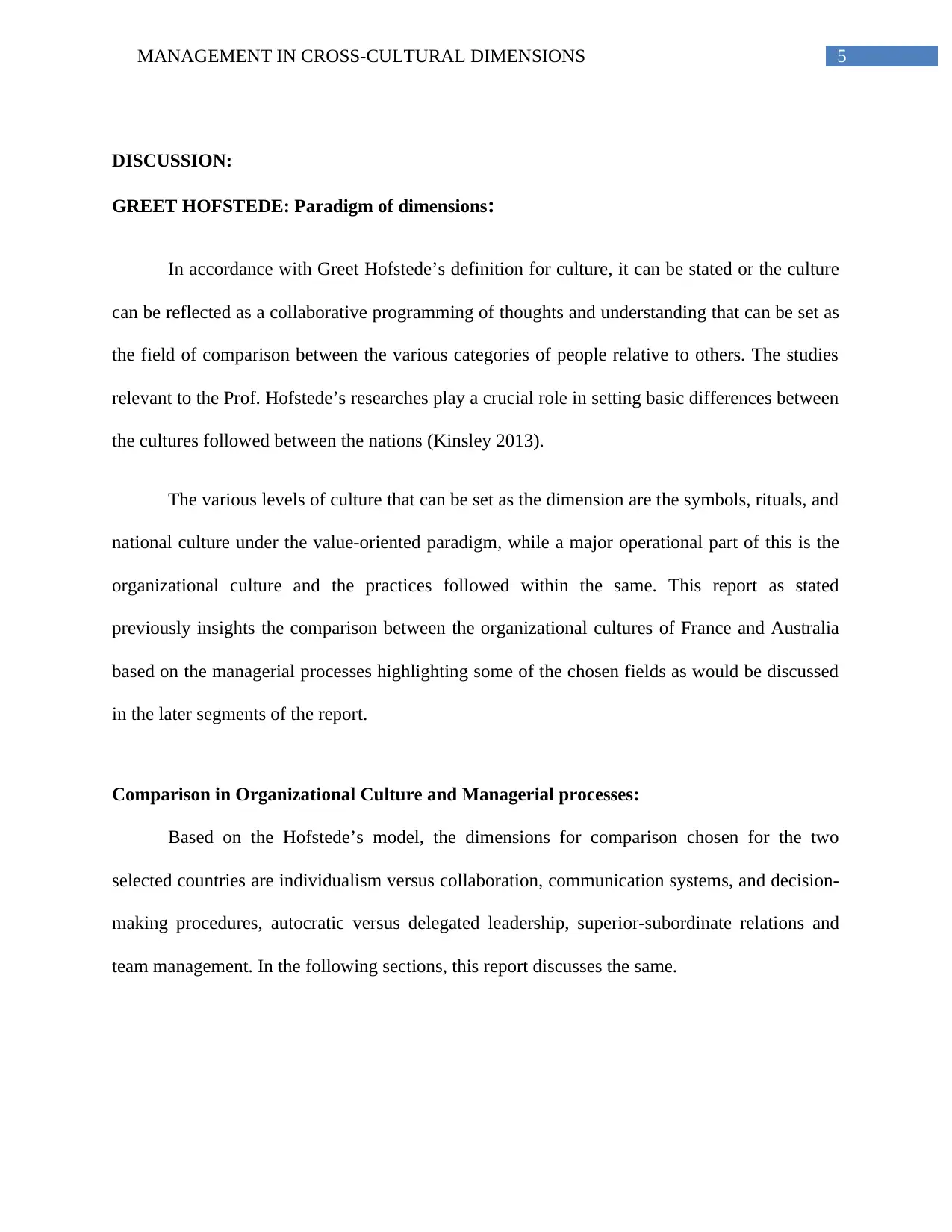
5MANAGEMENT IN CROSS-CULTURAL DIMENSIONS
DISCUSSION:
GREET HOFSTEDE: Paradigm of dimensions:
In accordance with Greet Hofstede’s definition for culture, it can be stated or the culture
can be reflected as a collaborative programming of thoughts and understanding that can be set as
the field of comparison between the various categories of people relative to others. The studies
relevant to the Prof. Hofstede’s researches play a crucial role in setting basic differences between
the cultures followed between the nations (Kinsley 2013).
The various levels of culture that can be set as the dimension are the symbols, rituals, and
national culture under the value-oriented paradigm, while a major operational part of this is the
organizational culture and the practices followed within the same. This report as stated
previously insights the comparison between the organizational cultures of France and Australia
based on the managerial processes highlighting some of the chosen fields as would be discussed
in the later segments of the report.
Comparison in Organizational Culture and Managerial processes:
Based on the Hofstede’s model, the dimensions for comparison chosen for the two
selected countries are individualism versus collaboration, communication systems, and decision-
making procedures, autocratic versus delegated leadership, superior-subordinate relations and
team management. In the following sections, this report discusses the same.
DISCUSSION:
GREET HOFSTEDE: Paradigm of dimensions:
In accordance with Greet Hofstede’s definition for culture, it can be stated or the culture
can be reflected as a collaborative programming of thoughts and understanding that can be set as
the field of comparison between the various categories of people relative to others. The studies
relevant to the Prof. Hofstede’s researches play a crucial role in setting basic differences between
the cultures followed between the nations (Kinsley 2013).
The various levels of culture that can be set as the dimension are the symbols, rituals, and
national culture under the value-oriented paradigm, while a major operational part of this is the
organizational culture and the practices followed within the same. This report as stated
previously insights the comparison between the organizational cultures of France and Australia
based on the managerial processes highlighting some of the chosen fields as would be discussed
in the later segments of the report.
Comparison in Organizational Culture and Managerial processes:
Based on the Hofstede’s model, the dimensions for comparison chosen for the two
selected countries are individualism versus collaboration, communication systems, and decision-
making procedures, autocratic versus delegated leadership, superior-subordinate relations and
team management. In the following sections, this report discusses the same.
⊘ This is a preview!⊘
Do you want full access?
Subscribe today to unlock all pages.

Trusted by 1+ million students worldwide
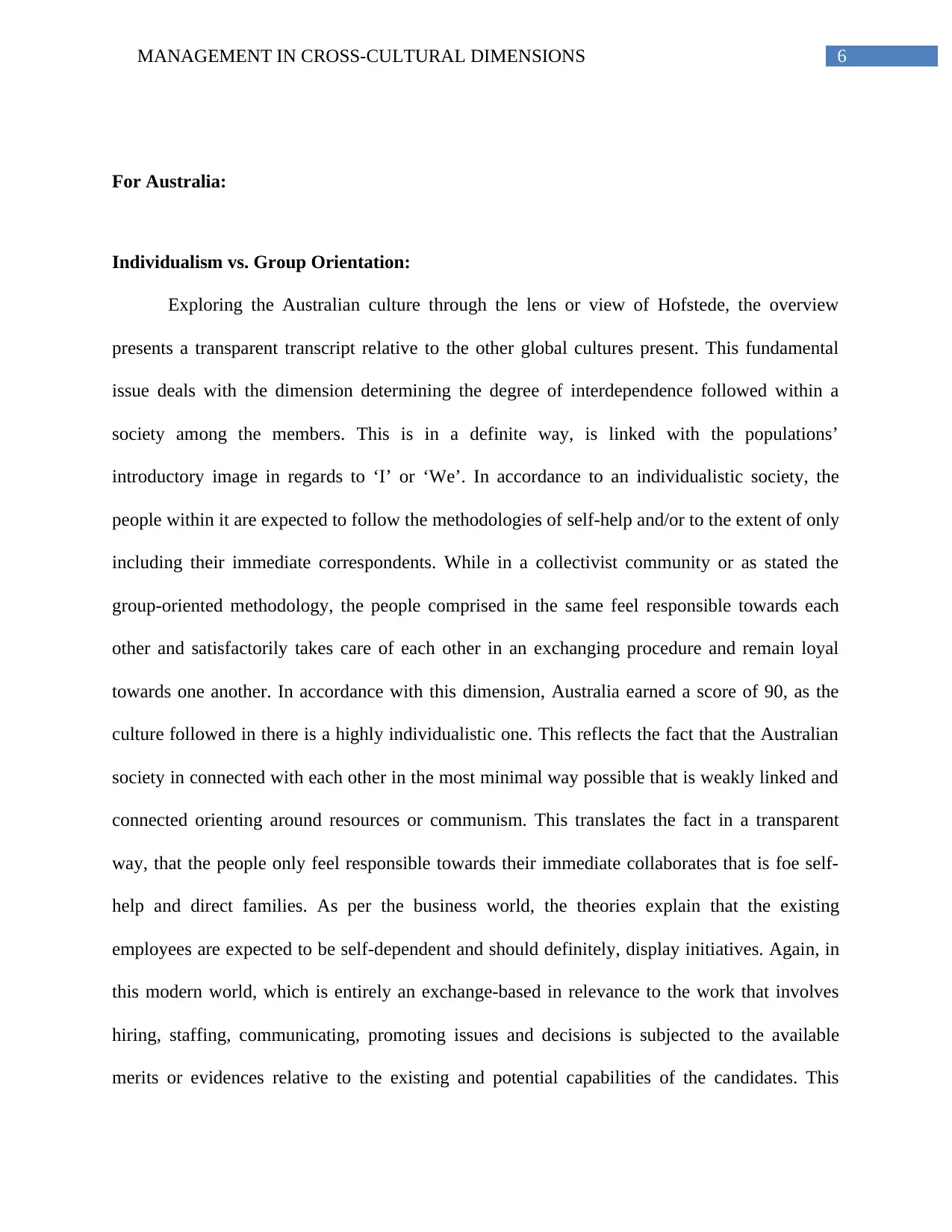
6MANAGEMENT IN CROSS-CULTURAL DIMENSIONS
For Australia:
Individualism vs. Group Orientation:
Exploring the Australian culture through the lens or view of Hofstede, the overview
presents a transparent transcript relative to the other global cultures present. This fundamental
issue deals with the dimension determining the degree of interdependence followed within a
society among the members. This is in a definite way, is linked with the populations’
introductory image in regards to ‘I’ or ‘We’. In accordance to an individualistic society, the
people within it are expected to follow the methodologies of self-help and/or to the extent of only
including their immediate correspondents. While in a collectivist community or as stated the
group-oriented methodology, the people comprised in the same feel responsible towards each
other and satisfactorily takes care of each other in an exchanging procedure and remain loyal
towards one another. In accordance with this dimension, Australia earned a score of 90, as the
culture followed in there is a highly individualistic one. This reflects the fact that the Australian
society in connected with each other in the most minimal way possible that is weakly linked and
connected orienting around resources or communism. This translates the fact in a transparent
way, that the people only feel responsible towards their immediate collaborates that is foe self-
help and direct families. As per the business world, the theories explain that the existing
employees are expected to be self-dependent and should definitely, display initiatives. Again, in
this modern world, which is entirely an exchange-based in relevance to the work that involves
hiring, staffing, communicating, promoting issues and decisions is subjected to the available
merits or evidences relative to the existing and potential capabilities of the candidates. This
For Australia:
Individualism vs. Group Orientation:
Exploring the Australian culture through the lens or view of Hofstede, the overview
presents a transparent transcript relative to the other global cultures present. This fundamental
issue deals with the dimension determining the degree of interdependence followed within a
society among the members. This is in a definite way, is linked with the populations’
introductory image in regards to ‘I’ or ‘We’. In accordance to an individualistic society, the
people within it are expected to follow the methodologies of self-help and/or to the extent of only
including their immediate correspondents. While in a collectivist community or as stated the
group-oriented methodology, the people comprised in the same feel responsible towards each
other and satisfactorily takes care of each other in an exchanging procedure and remain loyal
towards one another. In accordance with this dimension, Australia earned a score of 90, as the
culture followed in there is a highly individualistic one. This reflects the fact that the Australian
society in connected with each other in the most minimal way possible that is weakly linked and
connected orienting around resources or communism. This translates the fact in a transparent
way, that the people only feel responsible towards their immediate collaborates that is foe self-
help and direct families. As per the business world, the theories explain that the existing
employees are expected to be self-dependent and should definitely, display initiatives. Again, in
this modern world, which is entirely an exchange-based in relevance to the work that involves
hiring, staffing, communicating, promoting issues and decisions is subjected to the available
merits or evidences relative to the existing and potential capabilities of the candidates. This
Paraphrase This Document
Need a fresh take? Get an instant paraphrase of this document with our AI Paraphraser
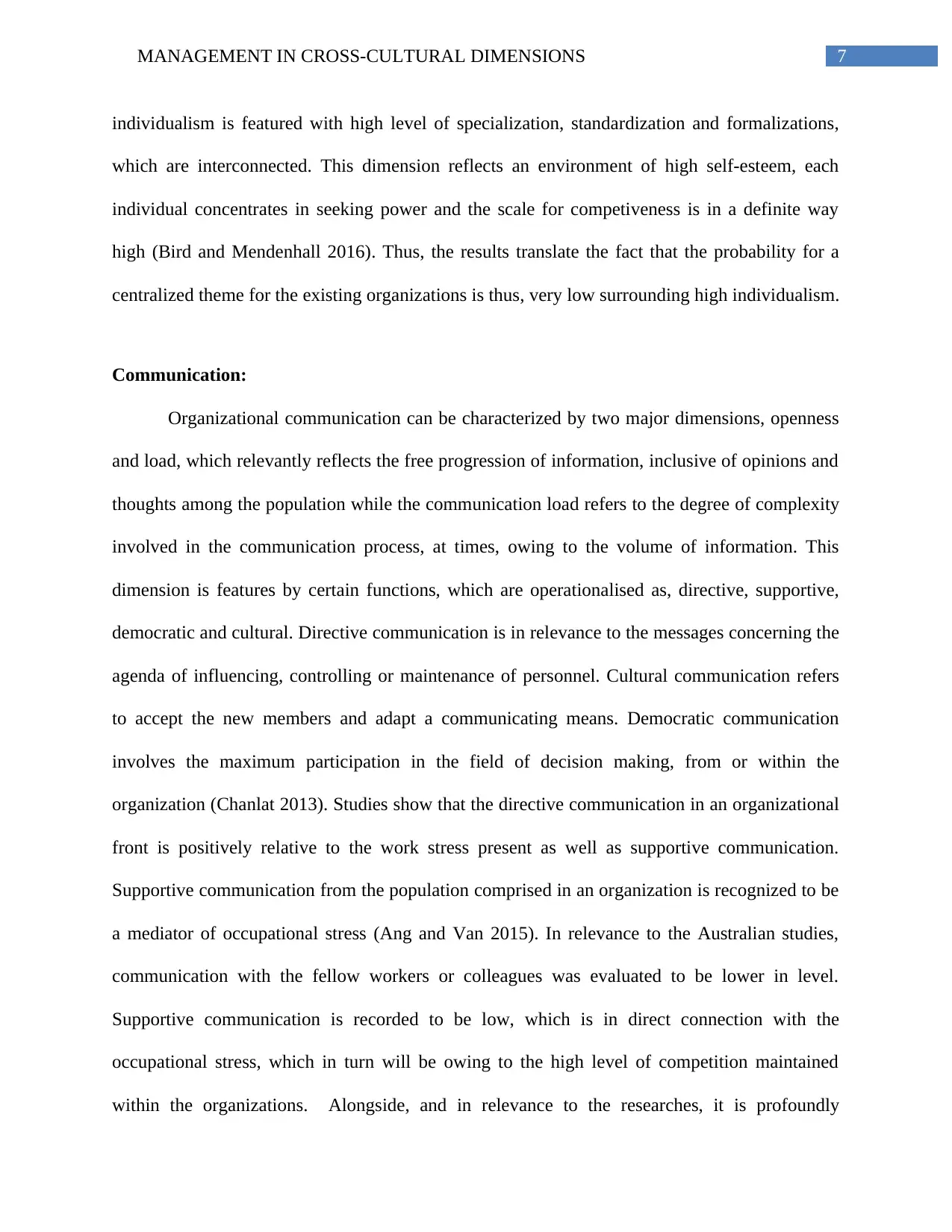
7MANAGEMENT IN CROSS-CULTURAL DIMENSIONS
individualism is featured with high level of specialization, standardization and formalizations,
which are interconnected. This dimension reflects an environment of high self-esteem, each
individual concentrates in seeking power and the scale for competiveness is in a definite way
high (Bird and Mendenhall 2016). Thus, the results translate the fact that the probability for a
centralized theme for the existing organizations is thus, very low surrounding high individualism.
Communication:
Organizational communication can be characterized by two major dimensions, openness
and load, which relevantly reflects the free progression of information, inclusive of opinions and
thoughts among the population while the communication load refers to the degree of complexity
involved in the communication process, at times, owing to the volume of information. This
dimension is features by certain functions, which are operationalised as, directive, supportive,
democratic and cultural. Directive communication is in relevance to the messages concerning the
agenda of influencing, controlling or maintenance of personnel. Cultural communication refers
to accept the new members and adapt a communicating means. Democratic communication
involves the maximum participation in the field of decision making, from or within the
organization (Chanlat 2013). Studies show that the directive communication in an organizational
front is positively relative to the work stress present as well as supportive communication.
Supportive communication from the population comprised in an organization is recognized to be
a mediator of occupational stress (Ang and Van 2015). In relevance to the Australian studies,
communication with the fellow workers or colleagues was evaluated to be lower in level.
Supportive communication is recorded to be low, which is in direct connection with the
occupational stress, which in turn will be owing to the high level of competition maintained
within the organizations. Alongside, and in relevance to the researches, it is profoundly
individualism is featured with high level of specialization, standardization and formalizations,
which are interconnected. This dimension reflects an environment of high self-esteem, each
individual concentrates in seeking power and the scale for competiveness is in a definite way
high (Bird and Mendenhall 2016). Thus, the results translate the fact that the probability for a
centralized theme for the existing organizations is thus, very low surrounding high individualism.
Communication:
Organizational communication can be characterized by two major dimensions, openness
and load, which relevantly reflects the free progression of information, inclusive of opinions and
thoughts among the population while the communication load refers to the degree of complexity
involved in the communication process, at times, owing to the volume of information. This
dimension is features by certain functions, which are operationalised as, directive, supportive,
democratic and cultural. Directive communication is in relevance to the messages concerning the
agenda of influencing, controlling or maintenance of personnel. Cultural communication refers
to accept the new members and adapt a communicating means. Democratic communication
involves the maximum participation in the field of decision making, from or within the
organization (Chanlat 2013). Studies show that the directive communication in an organizational
front is positively relative to the work stress present as well as supportive communication.
Supportive communication from the population comprised in an organization is recognized to be
a mediator of occupational stress (Ang and Van 2015). In relevance to the Australian studies,
communication with the fellow workers or colleagues was evaluated to be lower in level.
Supportive communication is recorded to be low, which is in direct connection with the
occupational stress, which in turn will be owing to the high level of competition maintained
within the organizations. Alongside, and in relevance to the researches, it is profoundly
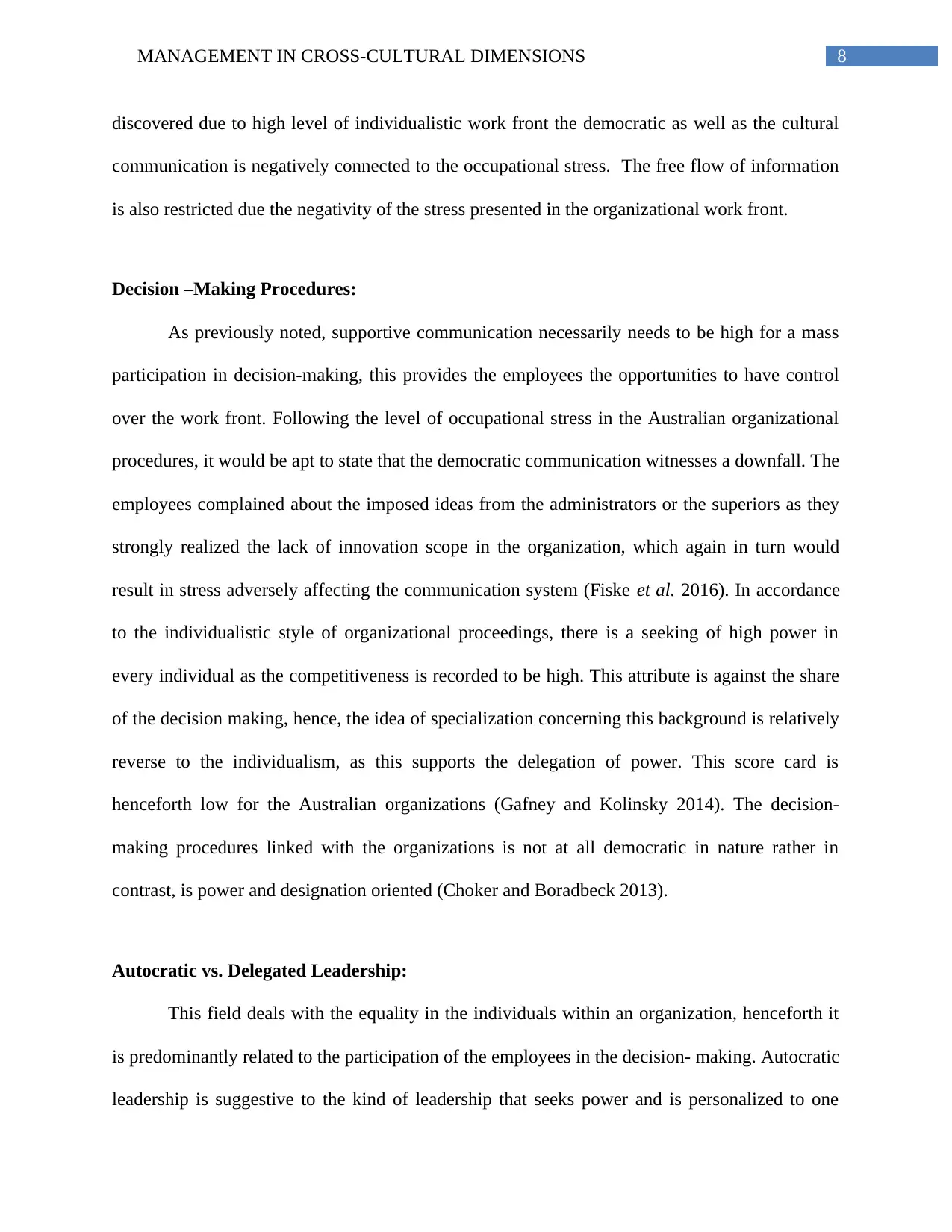
8MANAGEMENT IN CROSS-CULTURAL DIMENSIONS
discovered due to high level of individualistic work front the democratic as well as the cultural
communication is negatively connected to the occupational stress. The free flow of information
is also restricted due the negativity of the stress presented in the organizational work front.
Decision –Making Procedures:
As previously noted, supportive communication necessarily needs to be high for a mass
participation in decision-making, this provides the employees the opportunities to have control
over the work front. Following the level of occupational stress in the Australian organizational
procedures, it would be apt to state that the democratic communication witnesses a downfall. The
employees complained about the imposed ideas from the administrators or the superiors as they
strongly realized the lack of innovation scope in the organization, which again in turn would
result in stress adversely affecting the communication system (Fiske et al. 2016). In accordance
to the individualistic style of organizational proceedings, there is a seeking of high power in
every individual as the competitiveness is recorded to be high. This attribute is against the share
of the decision making, hence, the idea of specialization concerning this background is relatively
reverse to the individualism, as this supports the delegation of power. This score card is
henceforth low for the Australian organizations (Gafney and Kolinsky 2014). The decision-
making procedures linked with the organizations is not at all democratic in nature rather in
contrast, is power and designation oriented (Choker and Boradbeck 2013).
Autocratic vs. Delegated Leadership:
This field deals with the equality in the individuals within an organization, henceforth it
is predominantly related to the participation of the employees in the decision- making. Autocratic
leadership is suggestive to the kind of leadership that seeks power and is personalized to one
discovered due to high level of individualistic work front the democratic as well as the cultural
communication is negatively connected to the occupational stress. The free flow of information
is also restricted due the negativity of the stress presented in the organizational work front.
Decision –Making Procedures:
As previously noted, supportive communication necessarily needs to be high for a mass
participation in decision-making, this provides the employees the opportunities to have control
over the work front. Following the level of occupational stress in the Australian organizational
procedures, it would be apt to state that the democratic communication witnesses a downfall. The
employees complained about the imposed ideas from the administrators or the superiors as they
strongly realized the lack of innovation scope in the organization, which again in turn would
result in stress adversely affecting the communication system (Fiske et al. 2016). In accordance
to the individualistic style of organizational proceedings, there is a seeking of high power in
every individual as the competitiveness is recorded to be high. This attribute is against the share
of the decision making, hence, the idea of specialization concerning this background is relatively
reverse to the individualism, as this supports the delegation of power. This score card is
henceforth low for the Australian organizations (Gafney and Kolinsky 2014). The decision-
making procedures linked with the organizations is not at all democratic in nature rather in
contrast, is power and designation oriented (Choker and Boradbeck 2013).
Autocratic vs. Delegated Leadership:
This field deals with the equality in the individuals within an organization, henceforth it
is predominantly related to the participation of the employees in the decision- making. Autocratic
leadership is suggestive to the kind of leadership that seeks power and is personalized to one
⊘ This is a preview!⊘
Do you want full access?
Subscribe today to unlock all pages.

Trusted by 1+ million students worldwide
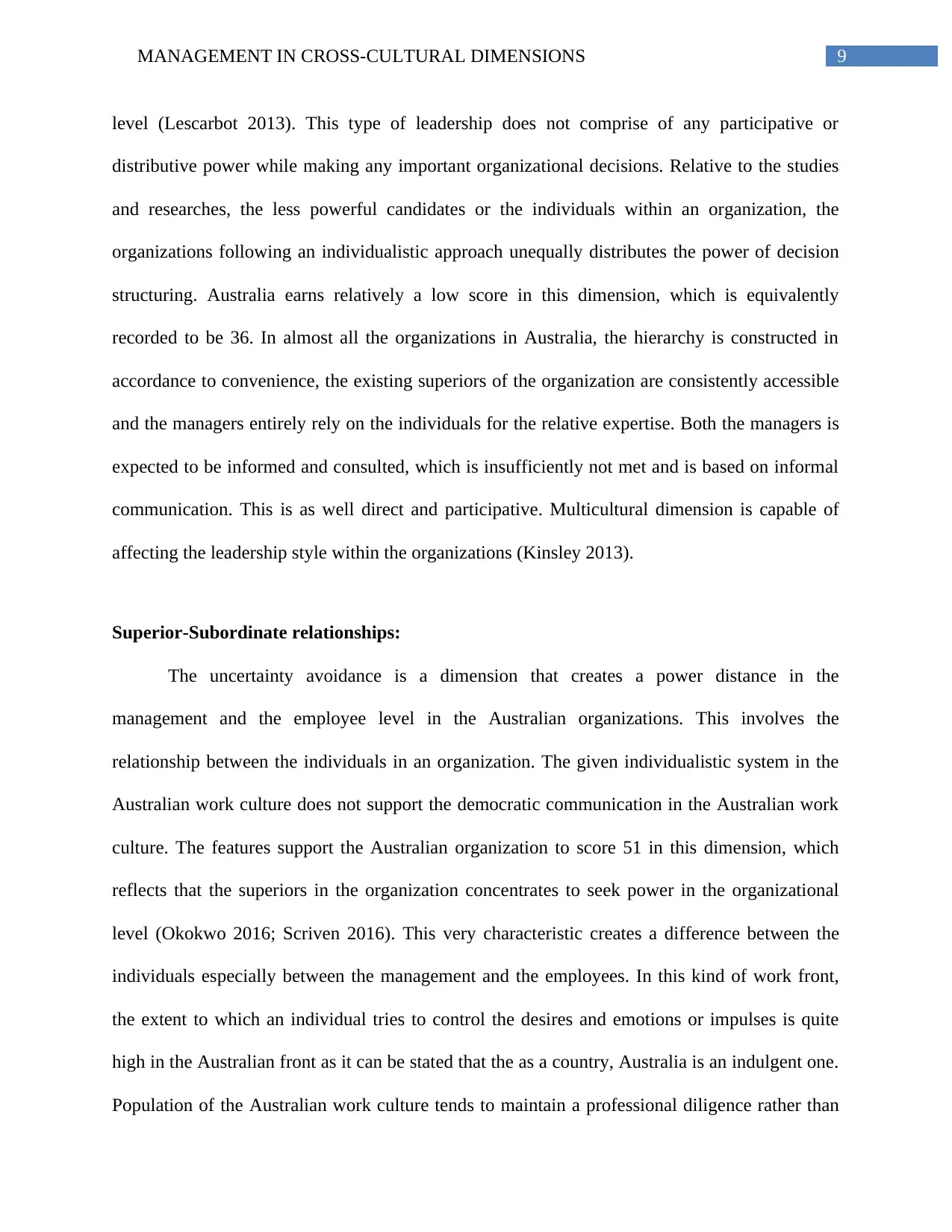
9MANAGEMENT IN CROSS-CULTURAL DIMENSIONS
level (Lescarbot 2013). This type of leadership does not comprise of any participative or
distributive power while making any important organizational decisions. Relative to the studies
and researches, the less powerful candidates or the individuals within an organization, the
organizations following an individualistic approach unequally distributes the power of decision
structuring. Australia earns relatively a low score in this dimension, which is equivalently
recorded to be 36. In almost all the organizations in Australia, the hierarchy is constructed in
accordance to convenience, the existing superiors of the organization are consistently accessible
and the managers entirely rely on the individuals for the relative expertise. Both the managers is
expected to be informed and consulted, which is insufficiently not met and is based on informal
communication. This is as well direct and participative. Multicultural dimension is capable of
affecting the leadership style within the organizations (Kinsley 2013).
Superior-Subordinate relationships:
The uncertainty avoidance is a dimension that creates a power distance in the
management and the employee level in the Australian organizations. This involves the
relationship between the individuals in an organization. The given individualistic system in the
Australian work culture does not support the democratic communication in the Australian work
culture. The features support the Australian organization to score 51 in this dimension, which
reflects that the superiors in the organization concentrates to seek power in the organizational
level (Okokwo 2016; Scriven 2016). This very characteristic creates a difference between the
individuals especially between the management and the employees. In this kind of work front,
the extent to which an individual tries to control the desires and emotions or impulses is quite
high in the Australian front as it can be stated that the as a country, Australia is an indulgent one.
Population of the Australian work culture tends to maintain a professional diligence rather than
level (Lescarbot 2013). This type of leadership does not comprise of any participative or
distributive power while making any important organizational decisions. Relative to the studies
and researches, the less powerful candidates or the individuals within an organization, the
organizations following an individualistic approach unequally distributes the power of decision
structuring. Australia earns relatively a low score in this dimension, which is equivalently
recorded to be 36. In almost all the organizations in Australia, the hierarchy is constructed in
accordance to convenience, the existing superiors of the organization are consistently accessible
and the managers entirely rely on the individuals for the relative expertise. Both the managers is
expected to be informed and consulted, which is insufficiently not met and is based on informal
communication. This is as well direct and participative. Multicultural dimension is capable of
affecting the leadership style within the organizations (Kinsley 2013).
Superior-Subordinate relationships:
The uncertainty avoidance is a dimension that creates a power distance in the
management and the employee level in the Australian organizations. This involves the
relationship between the individuals in an organization. The given individualistic system in the
Australian work culture does not support the democratic communication in the Australian work
culture. The features support the Australian organization to score 51 in this dimension, which
reflects that the superiors in the organization concentrates to seek power in the organizational
level (Okokwo 2016; Scriven 2016). This very characteristic creates a difference between the
individuals especially between the management and the employees. In this kind of work front,
the extent to which an individual tries to control the desires and emotions or impulses is quite
high in the Australian front as it can be stated that the as a country, Australia is an indulgent one.
Population of the Australian work culture tends to maintain a professional diligence rather than
Paraphrase This Document
Need a fresh take? Get an instant paraphrase of this document with our AI Paraphraser
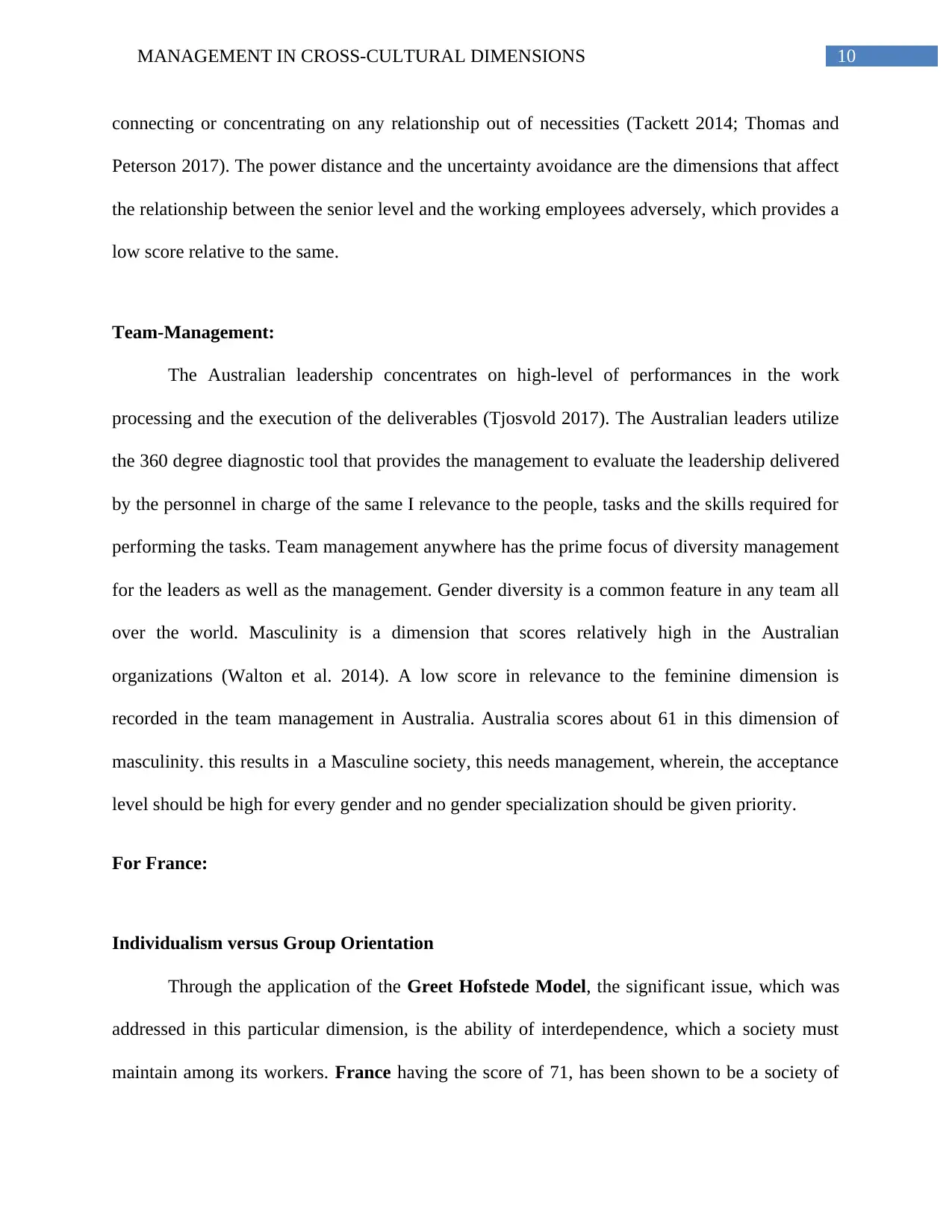
10MANAGEMENT IN CROSS-CULTURAL DIMENSIONS
connecting or concentrating on any relationship out of necessities (Tackett 2014; Thomas and
Peterson 2017). The power distance and the uncertainty avoidance are the dimensions that affect
the relationship between the senior level and the working employees adversely, which provides a
low score relative to the same.
Team-Management:
The Australian leadership concentrates on high-level of performances in the work
processing and the execution of the deliverables (Tjosvold 2017). The Australian leaders utilize
the 360 degree diagnostic tool that provides the management to evaluate the leadership delivered
by the personnel in charge of the same I relevance to the people, tasks and the skills required for
performing the tasks. Team management anywhere has the prime focus of diversity management
for the leaders as well as the management. Gender diversity is a common feature in any team all
over the world. Masculinity is a dimension that scores relatively high in the Australian
organizations (Walton et al. 2014). A low score in relevance to the feminine dimension is
recorded in the team management in Australia. Australia scores about 61 in this dimension of
masculinity. this results in a Masculine society, this needs management, wherein, the acceptance
level should be high for every gender and no gender specialization should be given priority.
For France:
Individualism versus Group Orientation
Through the application of the Greet Hofstede Model, the significant issue, which was
addressed in this particular dimension, is the ability of interdependence, which a society must
maintain among its workers. France having the score of 71, has been shown to be a society of
connecting or concentrating on any relationship out of necessities (Tackett 2014; Thomas and
Peterson 2017). The power distance and the uncertainty avoidance are the dimensions that affect
the relationship between the senior level and the working employees adversely, which provides a
low score relative to the same.
Team-Management:
The Australian leadership concentrates on high-level of performances in the work
processing and the execution of the deliverables (Tjosvold 2017). The Australian leaders utilize
the 360 degree diagnostic tool that provides the management to evaluate the leadership delivered
by the personnel in charge of the same I relevance to the people, tasks and the skills required for
performing the tasks. Team management anywhere has the prime focus of diversity management
for the leaders as well as the management. Gender diversity is a common feature in any team all
over the world. Masculinity is a dimension that scores relatively high in the Australian
organizations (Walton et al. 2014). A low score in relevance to the feminine dimension is
recorded in the team management in Australia. Australia scores about 61 in this dimension of
masculinity. this results in a Masculine society, this needs management, wherein, the acceptance
level should be high for every gender and no gender specialization should be given priority.
For France:
Individualism versus Group Orientation
Through the application of the Greet Hofstede Model, the significant issue, which was
addressed in this particular dimension, is the ability of interdependence, which a society must
maintain among its workers. France having the score of 71, has been shown to be a society of
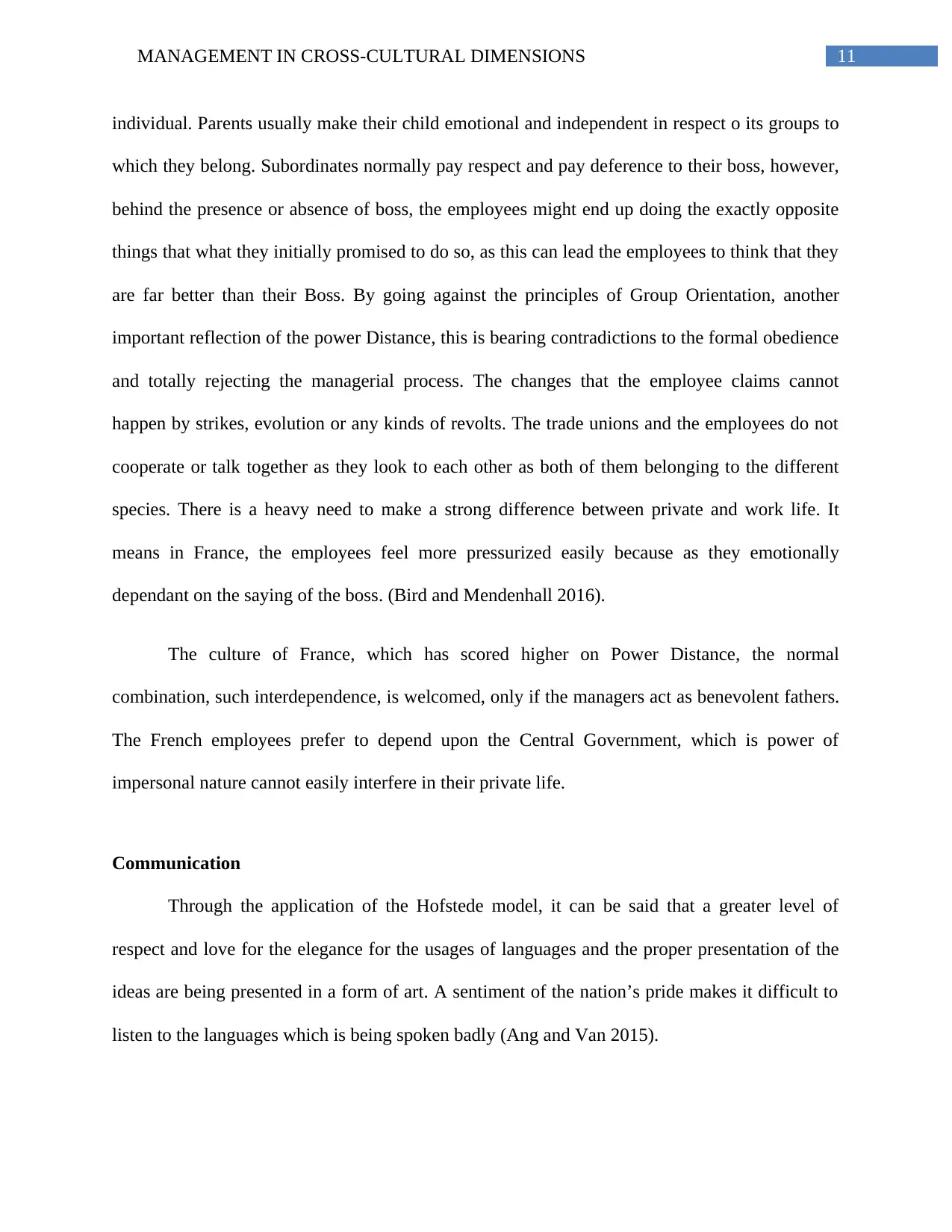
11MANAGEMENT IN CROSS-CULTURAL DIMENSIONS
individual. Parents usually make their child emotional and independent in respect o its groups to
which they belong. Subordinates normally pay respect and pay deference to their boss, however,
behind the presence or absence of boss, the employees might end up doing the exactly opposite
things that what they initially promised to do so, as this can lead the employees to think that they
are far better than their Boss. By going against the principles of Group Orientation, another
important reflection of the power Distance, this is bearing contradictions to the formal obedience
and totally rejecting the managerial process. The changes that the employee claims cannot
happen by strikes, evolution or any kinds of revolts. The trade unions and the employees do not
cooperate or talk together as they look to each other as both of them belonging to the different
species. There is a heavy need to make a strong difference between private and work life. It
means in France, the employees feel more pressurized easily because as they emotionally
dependant on the saying of the boss. (Bird and Mendenhall 2016).
The culture of France, which has scored higher on Power Distance, the normal
combination, such interdependence, is welcomed, only if the managers act as benevolent fathers.
The French employees prefer to depend upon the Central Government, which is power of
impersonal nature cannot easily interfere in their private life.
Communication
Through the application of the Hofstede model, it can be said that a greater level of
respect and love for the elegance for the usages of languages and the proper presentation of the
ideas are being presented in a form of art. A sentiment of the nation’s pride makes it difficult to
listen to the languages which is being spoken badly (Ang and Van 2015).
individual. Parents usually make their child emotional and independent in respect o its groups to
which they belong. Subordinates normally pay respect and pay deference to their boss, however,
behind the presence or absence of boss, the employees might end up doing the exactly opposite
things that what they initially promised to do so, as this can lead the employees to think that they
are far better than their Boss. By going against the principles of Group Orientation, another
important reflection of the power Distance, this is bearing contradictions to the formal obedience
and totally rejecting the managerial process. The changes that the employee claims cannot
happen by strikes, evolution or any kinds of revolts. The trade unions and the employees do not
cooperate or talk together as they look to each other as both of them belonging to the different
species. There is a heavy need to make a strong difference between private and work life. It
means in France, the employees feel more pressurized easily because as they emotionally
dependant on the saying of the boss. (Bird and Mendenhall 2016).
The culture of France, which has scored higher on Power Distance, the normal
combination, such interdependence, is welcomed, only if the managers act as benevolent fathers.
The French employees prefer to depend upon the Central Government, which is power of
impersonal nature cannot easily interfere in their private life.
Communication
Through the application of the Hofstede model, it can be said that a greater level of
respect and love for the elegance for the usages of languages and the proper presentation of the
ideas are being presented in a form of art. A sentiment of the nation’s pride makes it difficult to
listen to the languages which is being spoken badly (Ang and Van 2015).
⊘ This is a preview!⊘
Do you want full access?
Subscribe today to unlock all pages.

Trusted by 1+ million students worldwide
1 out of 20
Related Documents
Your All-in-One AI-Powered Toolkit for Academic Success.
+13062052269
info@desklib.com
Available 24*7 on WhatsApp / Email
![[object Object]](/_next/static/media/star-bottom.7253800d.svg)
Unlock your academic potential
Copyright © 2020–2025 A2Z Services. All Rights Reserved. Developed and managed by ZUCOL.




